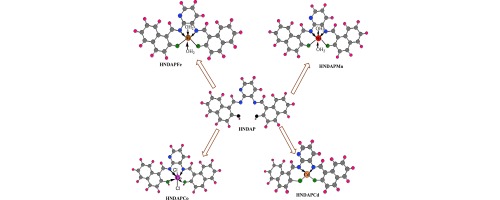This study highlights synthesis and characterization of a tetradentate ONNO Schiff base ligand namely (1, 1′- (pyridine-2, 3-dimethyliminomethyl) naphthalene-2, 2′-diol) and hereafter denotes as “HNDAP″ and selected metal complexes including Mn(II), Fe(II), Co(II) and Cd(II) as a central metal. HNDAP was synthesized from 1:2 M ratio condensation of 2, 3-diaminopyridine and 2- hydroxy-1-naphthaldhyde, respectively. The stoichiometric ratios of the prepared complexes were estimated using complementary techniques such as; elemental analyses (-C, H, N), FT-IR, magnetic measurements and molar conductivity. Furthermore, their physicochemical studies were carried out using thermal TGA, DTA and kinetic–thermodynamic studies along with DFT calculations. The results of elemental analyses showed that these complexes are present in a 1:1 metal-to- ligand molar ratio. Moreover, the magnetic susceptibilities values at room temperature revealed that Mn(II), Fe(II) and Co(II) complexes are paramagnetic in nature and have an octahedral (Oh) geometry. In contrast, Cd(II) is diamagnetic and stabilizes in square planar sites. The molar conductivity measurements indicated that all complexes are nonelectrolytes in dimethyl formamide. Spectral data suggested that the ligand is as tetradentate and coordinated with Co(II) ion through two phenolic OH and two azomethine nitrogen. However, for Mn(II), Fe(II) and Cd(II) complexes, the coordination occurred through two phenolic oxygen and two azomethine nitrogen with deprotonation of OH groups. The proposed chemical structures have been validated by quantum mechanicscalculations. Antimicrobial activities of both the HNDAP Schiff base ligand and its metal complexes were tested against strains of Gram (-ve) E. coli and Gram (+ve) B. subtilis and S. aureus bacteria and C. albicans, A. flavus and T. rubrum fungi. All the prepared compounds showed good results of inhibition against the selected pathogenic microorganisms. The investigated HNDAP Schiff base complexes showed higher activity and stability than their corresponding HNDAP Schiff base ligand and the highest activity observed for Cd(II) complex. Moreover, the prepared Schiff base ligand and its Mn(II) and Co(II) complexes have been evaluated for their anticancer activities against two cancer cell lines namely; colon carcinoma cells (HCT-116 cell line) and hepatocellular carcinoma (Hep-G2) cell lines The interaction of Mn(II) and Co(II) complexes with calf thymus DNA (CT-DNA) was studied by absorption spectroscopic technique and viscosity measurements. Both complexes showed a successful interaction with CT-DNA via intercalation mode.


